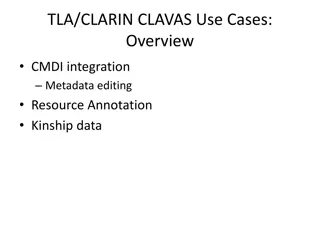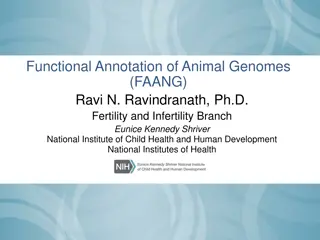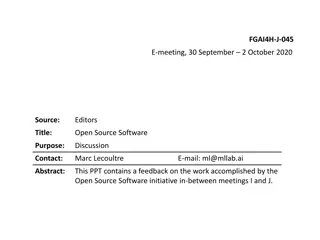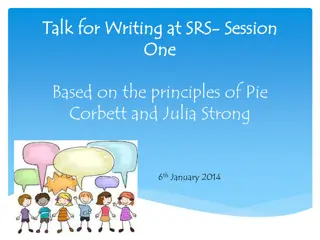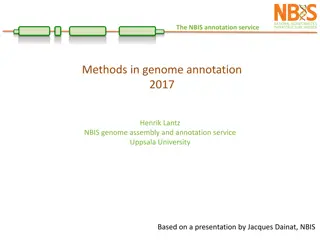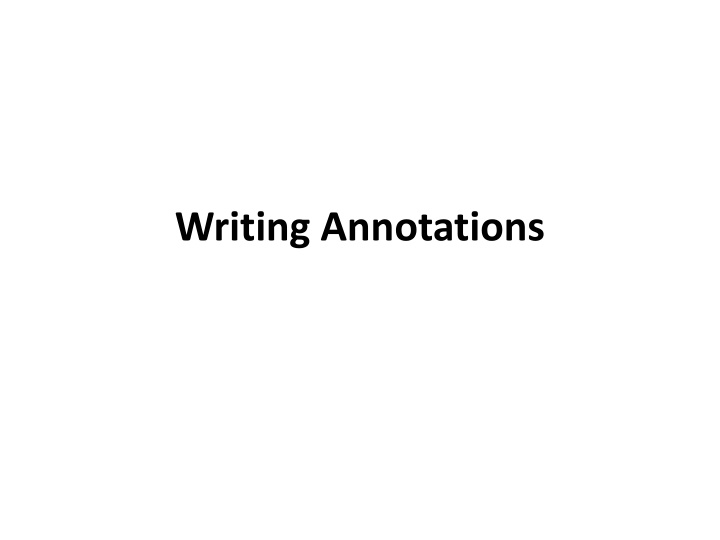
Mastering Annotation Writing: Types, Samples, and Effective Techniques
Learn about annotations and why they are essential, different types of annotations, a sample descriptive annotation, qualities of an effective annotation, and more. Enhance your writing skills for future publications, research, and presenting information clearly and concisely.
Uploaded on | 1 Views
Download Presentation

Please find below an Image/Link to download the presentation.
The content on the website is provided AS IS for your information and personal use only. It may not be sold, licensed, or shared on other websites without obtaining consent from the author. If you encounter any issues during the download, it is possible that the publisher has removed the file from their server.
You are allowed to download the files provided on this website for personal or commercial use, subject to the condition that they are used lawfully. All files are the property of their respective owners.
The content on the website is provided AS IS for your information and personal use only. It may not be sold, licensed, or shared on other websites without obtaining consent from the author.
E N D
Presentation Transcript
What is annotation? An annotation is a brief description of a book, article, or other publication, including audio- visual materials. The purpose of annotation is to characterize the publication in such a way that the reader can decide whether or not to read the complete work.
Why should You know how to write annotations? Helps you write annotations for future publications Helps you in conducting research Helps you present complex information in a clear, concise manner Helps you condense report information into a short format Helps you read annotations more effectively
Types of annotation Annotations vary according to their intended use and their content. Descriptive/Informative annotations describe the content of a book or article and indicate distinctive features. Critical annotations, in addition to describing the contents, evaluate the usefulness of a book or article for particular situations.
Sample descriptive annotation London, Herbert. "Five Myths of the Television Age." Television Quarterly 10(1) Spring 1982:81-89. The author explains how television contradicts five ideas commonly believed by most people, using specific examples seen on television, such as the assassination of John Kennedy, to demonstrate his points. His examples contradict such truisms as "seeing is believing", "a picture is worth a thousand words", and "satisfaction is its own reward." London uses logical arguments to support his ideas, and doesn't refer to any previous works on the topic: the article is his personal opinion.
Qualities of an effective annotation Uses one well-developed paragraph, which is unified, coherent, concise, and able to stand alone (between100 to 200 words) Adds no new information - merely summarizes Contains stand-alone qualities - the annotation can be understood without reading the paper Is understandable to a wide audience
Other annotation samples . . , // . - .: , 1989.- . 44-60. . .
. . : ? 2004 10 . , , . .
Market orientation for the Russian companies: setting problems, research and perspectives Keywords: innovation, marketing, market orientation, strategic marketing The article explains the problem questions from the field of market orientation of Russian companies: the distinctions in the terminology, the limitation of the existing methodology and the practical use by the managers. The authors give results of research among 216 companies of Moscow methodology of how to study the market orientation within internal environment of the company and describe the perspective of the follow up research. region, develop
How do I write an annotation? Read the text carefully and answer the question: What is the text about? Formulate the main topic and subtopics Break the text into logical parts, give them titles Start annotation with bibliography (the author, title, publisher,etc) Start sentences with the typical phrases (clich ): the article discribes , the paper shows , the publication deals with etc. Use passive constructions
Clichs for annotation writing The article introduces/presents/gives/describes The article reveals The article contains The article points out that The publication deals with The study/paper presents/discusses The paper shows/presents/regards/examines The author considers/outlines/concludes/ points out The author concentrates on The author views/reviews/ presents The author analyses how / examines why /
Clichs for annotation writing The author mentions/ stresses The author believes The author underlines that / outlines/ concludes According to the author/ in the author s opinion The author calls attention to the fact that . The author analyses/ compares/determines/states The author summarizes the results of Data shows/covers





